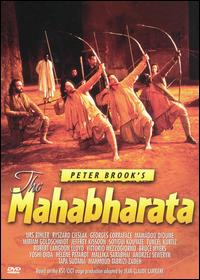| The Mahabharata | |
|---|---|
 DVD cover | |
| Directed by | Peter Brook |
| Written by | Peter Brook Jean-Claude Carrière Marie-Hélène Estienne |
| Starring | Robert Langton-Lloyd Antonin Stahly-Vishwanadan Bruce Myers Vittorio Mezzogiorno Andrzej Seweryn Georges Corraface Mallika Sarabhai |
| Cinematography | William Lubtchansky |
| Music by | Tsuchitori Toshiyuki Rabindranath Tagore |
| Distributed by | Virgin Vision [1] R.M. Associates [2] (United Kingdom) BAC Films (France) MK2 Productions (United States) Festival Video [3] (Australia) |
Release date |
|
Running time | 171 minutes (theatrical release) 330 minutes (miniseries) |
| Countries | United Kingdom Japan Denmark France Belgium United States Australia Ireland Iceland Sweden Portugal Norway Netherlands Finland |
| Language | English |
| Budget | $5 million |
The Mahabharata is a 1989 film version of the Hindu epic Mahabharata directed by Peter Brook. Brook's original 1985 stage play was nine hours in length and toured worldwide for four years. In 1989, and abridged adaptation, just short of six hours, was made as a television miniseries. This was in return edited into a nearly three-hour cut for theatrical release. The screenplay was the result of eight years' work by Brook, Jean-Claude Carrière and Marie-Hélène Estienne.